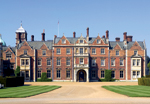Who owns Britain: The Royal Estates
It’s more difficult than one might think interpreting exactly how much land The Queen does or doesn’t own


Interpreting exactly how much land The Queen does, or does not, actually own is somewhat complicated. If we take The Crown Estate (including Windsor) and the uniquely organised Duchy of Lancaster out of the equation, we are left with the following estates that are, technically, The Queen's private property:
* Balmoral and Birkhall (formerly home to the Queen Mother, now used by Prince Charles)-comprising just over 46,000 acres on Royal Deeside in Aberdeenshire
* Delnadamph-a separate 8,000-acre estate in Aberdeenshire
* Sandringham-just under 20,000 acres in Norfolk
Total: 74,000 acres
The Duchy of Lancaster
Founded in the 13th century, the Duchy of Lancaster is an unusual anomaly in that it is a unique portfolio of land, property and assets, which is held in trust for the sovereign in his or her role as Duke of Lancaster. Now running to 46,456 acres-largely in the north of England, but with some highly lucrative land in London-the Duchy also comprises a further 123,553 acres of foreshore between the centre point of the River Mersey and Barrow-in-Furness. Although The Queen, who is the present Duke of Lancaster, receives revenues from the estate, the actual freeholder of the land is not clearly known.
Exquisite houses, the beauty of Nature, and how to get the most from your life, straight to your inbox.
Ship to shore
The Crown Estate owns 55% of the UK's foreshore-and the entire seabed out to the 12 nautical miles limit (some 23.6 million acres) although much of the coastal land is leased to third parties, such as local authorities and Natural England. Bodies such as the Duchies of Lancaster and Cornwall, local groups, port authorities, statutory bodies and Government agencies own the other 45%, together with:
* The Church Commissioners in Durham
* The Duke of Beaufort in the Severn Estuary
* The Beaulieu Estate on the River Beaulieu
In addition, The Crown Estate does not generally own the foreshore around the coastline of Cornwall, Sutherland and the Shetland Isles.
Country Life is unlike any other magazine: the only glossy weekly on the newsstand and the only magazine that has been guest-edited by His Majesty The King not once, but twice. It is a celebration of modern rural life and all its diverse joys and pleasures — that was first published in Queen Victoria's Diamond Jubilee year. Our eclectic mixture of witty and informative content — from the most up-to-date property news and commentary and a coveted glimpse inside some of the UK's best houses and gardens, to gardening, the arts and interior design, written by experts in their field — still cannot be found in print or online, anywhere else.
